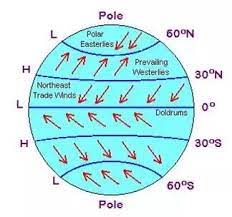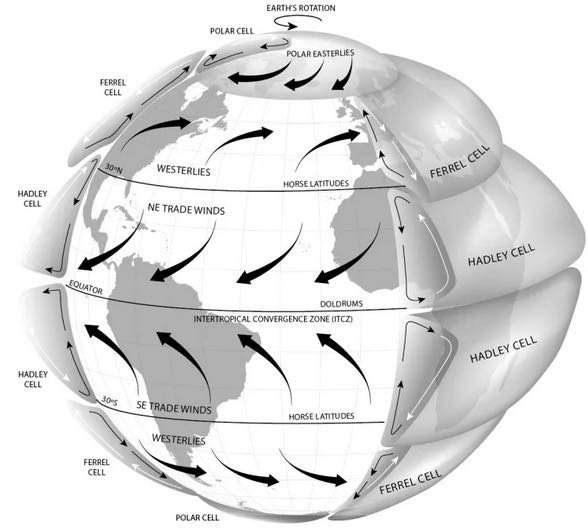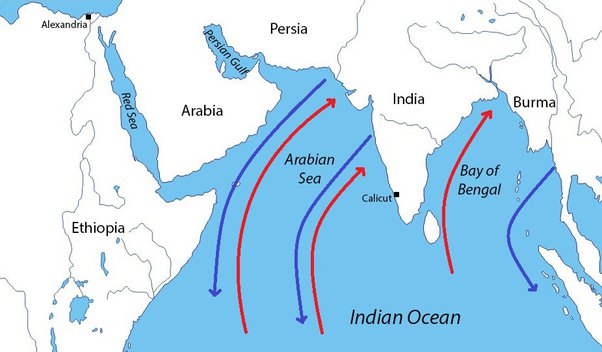Planetary winds are permanent winds. They are crucial components of the Earth’s weather system, shaping our climate and influencing the distribution of heat and moisture around the planet. These winds, driven by temperature gradients and other atmospheric forces, play a vital role in shaping our weather patterns and climate.

Table of Contents
Classification of Planetary Winds
Planetary winds can be broadly divided into two categories: global winds and local winds. Global winds are large-scale winds that circulate around the planet, driven by differences in temperature and pressure between the equator and poles. These winds include the trade winds, westerlies, and easterlies.

Trade Winds
Trade winds are steady are prevailing winds that blow from the subtropical high-pressure zones towards the equator in both the northern and southern hemispheres. These winds are characterized by their consistency, strength, and direction, and they are important to global weather patterns and ocean currents.

The trade winds get their name from their historical role in enabling trade ships to travel efficiently between Europe and the Americas by harnessing their consistent and reliable power. In addition to aiding in navigation, trade winds also play a crucial role in shaping the climate and ecosystems of regions around the world.
Easterlies
Easterlies are a type of prevailing wind that blow from the east to the west in both the northern and southern hemispheres. They are also known as the “Trade Winds,” “Tropical Easterlies,” or the “Northeast Trades” in the Northern Hemisphere and the “Southeast Trades” in the Southern Hemisphere.
Westerlies
Westerlies are prevailing winds that blow from the west in the middle latitudes, towards the east. They are driven by the low-pressure system over the poles and the high-pressure system over the subtropical regions. These winds play a vital role in shaping the climate of the middle latitudes, bringing moisture and warmth from the tropics towards the poles.
Polar Easterlies
Polar easterlies are the cold prevailing winds that blow from the high-pressure areas of the polar regions towards the subpolar low-pressure areas. They form when the cold air at the poles sinks and flows towards the equator, creating a high-pressure system. The Coriolis effect then deflects these winds to the west, resulting in the name “polar easterlies.”
"The direction of Polar Easterlies in the northern hemisphere is from North East to South West."
Local Winds
Local winds are winds that are generated by local temperature and pressure differences, such as sea breezes and land breezes. Sea breezes are winds that blow from the sea towards the land, driven by the cooling of the sea surface and the heating of the land. Land breezes, on the other hand, are winds that blow from the land towards the sea, driven by the cooling of the land and the heating of the sea surface.
Factors Affecting Planetary Winds
Planetary winds are driven by a number of factors, including differences in temperature, pressure, and atmospheric density. For example, winds are driven by the temperature gradient between the equator and poles, as well as by differences in pressure between the poles and the subtropical regions. In addition, winds are influenced by the Coriolis effect, which causes the winds to rotate around the planet in a clockwise direction in the Northern Hemisphere and in a counterclockwise direction in the Southern Hemisphere.
Effects of Planetary Winds
Planetary winds also play a crucial role in shaping our climate and influencing the distribution of heat and moisture around the planet. For example, the trade winds help to distribute heat and moisture from the equator towards the poles, while the westerlies bring moisture and warmth from the tropics towards the poles. The easterlies, on the other hand, distribute cold air and moisture from the poles towards the equator.
In addition to shaping our climate and influencing the distribution of heat and moisture, planetary winds also play a crucial role in shaping our weather patterns and the formation of storms. For example, strong westerlies can cause the formation of mid-latitude cyclones, which bring heavy precipitation and strong winds to the middle latitudes. Similarly, strong easterlies can cause the formation of polar lows, which bring cold air and heavy precipitation to the polar regions.
Application
Planetary winds are also important for a number of practical applications, such as air travel, shipping, and energy production. For example, air traffic controllers use information about planetary winds to make decisions about flight plans, helping to ensure the safety and efficiency of air travel. Shipping companies use information about planetary winds to optimize their routes, reducing fuel consumption and costs.
Planetary winds also play a critical role in renewable energy production, particularly wind and solar energy. For example, wind turbines generate electricity by harnessing the kinetic energy of the wind, and their efficiency is largely dependent on the strength and consistency of the planetary winds. Similarly, solar panels generate electricity by harnessing the energy of the sun, and their efficiency is influenced by local winds and atmospheric conditions.
Read: Geography